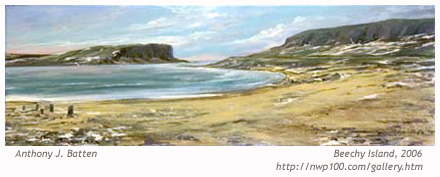Arctic Quest 2006 Artists Document Historic High Arctic Waters and Scenes
by admin ~ March 19th, 2007
25 Canadian artists travel part of the historic route of Norwegian explorer Roald Amundsen through the Northwest Passage, and document the splendor of northern lands and communities on canvas, paper and film.

Termed Arctic Quest 2006, the exhibit of their work has been on display since December 14, 2006 and will continue to June 14, 2007 at various locations. Exhibit will eventually become part of the permanent collection at the Vancouver Maritime Museum. A traveling exhibit of 25 works (1 from each artist) will be shown at the Legislative Assembly in Iqaliut in the summer of 2007 (as part of the Alainait Festival of the Arts), and at the Prince of Whales Northern Heritage Center in Yellowknife in the summer of 2008.

The project was launched in 2005, and is supported by Parks Canada, Sotheby’s, and numerous other supporters. The artists traveled for twelve days along the Arctic coasts of Baffin Island and Greenland, distributing art supplies and visiting with Inuit youth groups and artists along the way. On their return, they participated in various workshops, lectures, and historical projects, and are working to restore historic buildings in Pangnirtung to be used by local and visiting artists. The work of the group follows in the footsteps of earlier artists who have visited and documented life in the North: early European voyages of discovery, Group of Seven artists, and more recent artists such as Doris McCarthy and the late Dr. Maurice Haycock. More can be learned about Arctic Quest 2006 from the on-line gallery page, or their website which includes artist biographies, route map, historical resources, media coverage, and more.
.jpg)
March 21st, 2007 at 3:36 pm
That’s very cool. I like any project that manages to include environmental issues, art, and cultural and/or natural history.
Some really beautiful stuff, too.
March 21st, 2007 at 4:26 pm
Yea, their work is really subtle and serene. The project was conceived by three artists: Linda Mackey of Toronto, Kathy Haycock of Eganville, Ontario and Bonnie Levinthal of Pennsylvania. I’ve really enjoyed learning about this project and others that are part of the International Polar Year from March 2007 to March 2009 (two years for two polar regions: Arctic and Antarctic). There’s more to come.
Beechy Island is one of the locations where the mystery of the fateful 1845-48 John Franklin expedition started to become uncovered. The remains of some 30 crew members and gravestones were discovered by Scottish explorer and surveyor John Rae, who left in search of the expedition on three separate trips between 1848-1854. Toxicology and forensic analysis of their remains in the 1980s revealed high contents of lead poisoning, and possible death from pneumonia and tuberculosis (and other causes, such as starvation). It seems the solder in their canned food supplies, which was thought to be a significant technological advance at the time, had come into contact with the food. The findings were part of a Nova special, “Buried in Ice,” which originally aired in 1988.